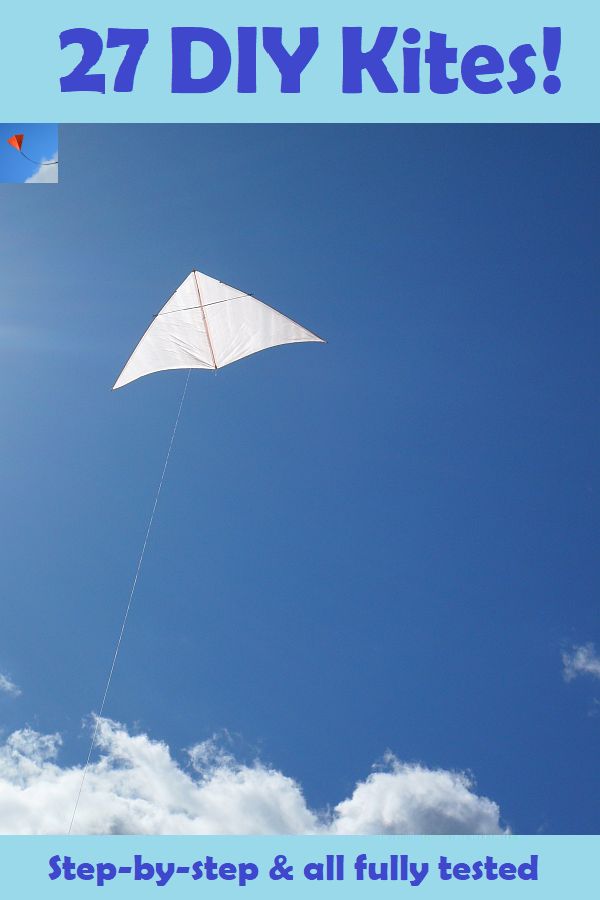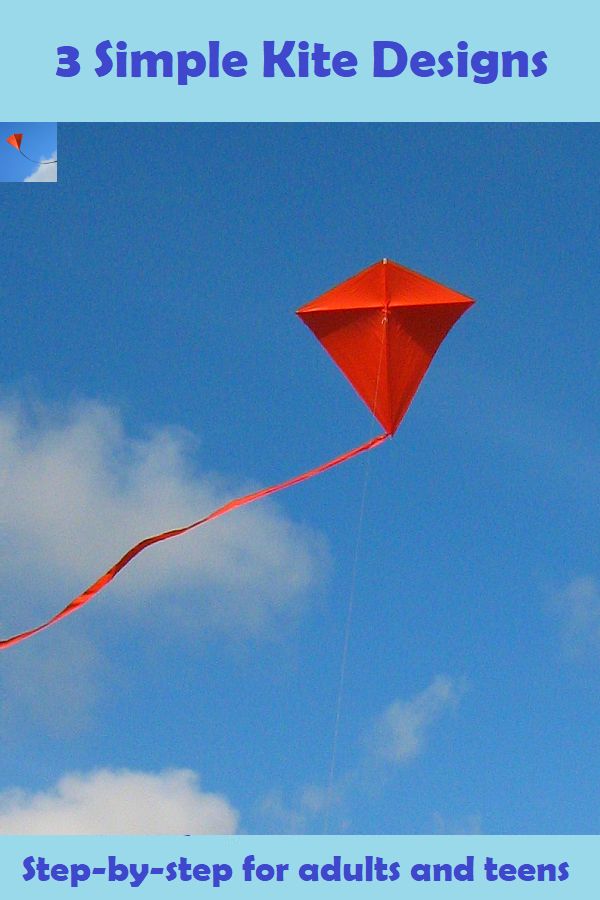- Home Page
- Paper Kites
How to Make Paper Kites
Paper and Tape—That's All!
If you want to know how to make paper kites, you have come to a good place.
A question: Can mere paper and sticky tape be used to make "real kites"? Craft that can fly really high and stay up for an hour or so? You bet!
The Paper Sled, Paper Diamond, Paper Rokkaku, Paper Sode, and Paper Delta have all been developed, refined, and successfully passed certification.
Yes, each kite in this series had to prove itself before I published the "How To ..." information on it.
Try Two Very Simple Designs First
The first of these requires the barest of breezes. The next one needs somewhat more puff out there. So you're covered for a range of breeze strengths!
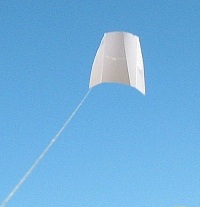 MBK Minimum Sled
MBK Minimum Sled1) The MBK Minimum Sled kite requires just a single sheet of A4- or Letter-sized copier paper.
Although it's strictly for fairly light winds, I've had reports of this design floating high for quite some time—on a sewing-thread line. Make one right now then wait for a suitable day to take it out.
Here's a flight report from when I first took out the Minimum Sled to a suitable location.
Does this kite have spars or not? Well, it has vertical folds in the sail that provide some extra stiffness just like separate spars. So perhaps, technically, it does have spars! That's a bit unique, don't you think?
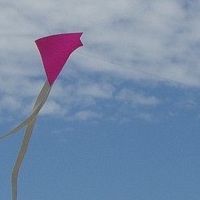 MBK Minimum Tetra
MBK Minimum Tetra2) The MBK Minimum Tetra kite is a ridiculously minimal tetrahedral featuring a single cell. Not surprisingly, it requires a tail to fly in a reasonable range of wind speeds.
Here's the flight report from when I took out the third and final prototype, featuring a colored paper sail.
If you want to get technical (OK, you don't but I do ;-) ) the cell is not actually a regular tetrahedron, where the faces are equilateral triangles.
With the sail made from a perfect square of paper, only two sides of each triangle are equal in length. You can stop yawning now, I'm done.
How to Make Paper Kites
In the MBK Paper Series
As already mentioned, each MBK Paper Series kite has proved itself in flight before the instructions were published.
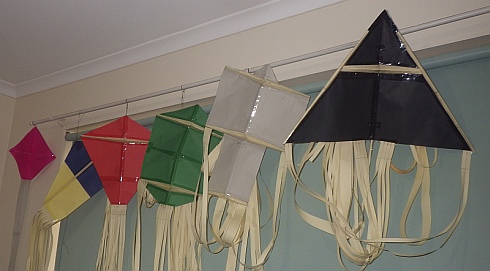 Paper Series originals (+ Minimum Tetra, far left)
Paper Series originals (+ Minimum Tetra, far left)Specifically, the kite had to do the following:
- reach an altitude of 200 feet above its tether point
- stay in the air unassisted for at least 20 minutes
- remain airworthy for 3 hours of total flight time
These designs are not as quick and simple to make as the Simple Series kites elsewhere on this site. However, they have the considerable advantage of not requiring any rigid spar material.
And yet, these small kites do have spars. But you make them yourself. By carefully following the instructions, the spars end up strong enough yet light enough to do the job for a particular type of kite. I've done all the hard work in tweaking it all to kite-flight perfection.
Don't forget—these are real kites. They fly high and stay up for ages! That's in reasonable weather, of course.
Got some copier paper at home? Some sticky tape? Hopefully, a reel of polyester sewing thread as well. You're ready to learn how to make paper kites! And fly one soon.
Each section below is dedicated to one of the five paper-kite designs.
For each design there is a link to a Flight Report. That page includes a video and several large photos of the original kite doing its thing.
I have tried to be generous in my estimates of construction time, below. You might do them quicker!
Enjoy learning how to make paper kites.
The MBK Paper Sled
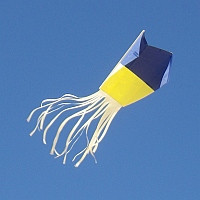 MBK Paper Sled
MBK Paper SledConstruction time: about 2 1/2 hours.
This design was inspired by one of the old Allison Sled designs that used two wooden spars. Of course, the Paper Sled is a different size and uses just copier paper and sticky tape throughout—even for the "sticks"!
Here are free instructions for making the MBK Paper Sled.
The last flight that this kite had for certification was a great one—50 minutes over the sand at a great height and being buzzed by seagulls!
Read about this kite's final certification flight. The photos and video in there were taken on the day. Check them out!
The MBK Paper Diamond
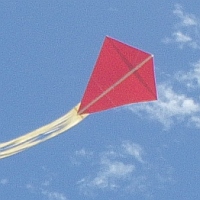 MBK Paper Diamond
MBK Paper DiamondConstruction time: about 3 hours.
This requires a bit less work on the sail but a bit more on the spars. Being only paper and tape, the spars have to be strong near the middle of the kite and lighter out near the tips.
After some experimentation with spar design, the final prototype was flown successfully for the full 3 hours, over several flights.
There's the colored build over in the photo.
Here are free instructions for making the MBK Paper Diamond.
Read about a sunny photo shoot down at the beach. In a sea breeze of ideal strength, the Paper Diamond posed high and low!
The MBK Paper Rokkaku
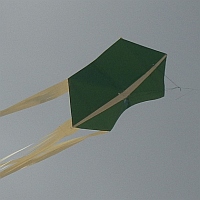 MBK Paper Rokkaku
MBK Paper RokkakuConstruction time: about 4 hours.
There's quite a bit of spar work on this kite. Even the vertical spar has dihedral as you can see in the photo!
This design floats down on its face in a stable fashion whenever the breeze drops below 12 kph or so. At the other end of the spectrum, the rok will stay in the air well into the fresh range of wind speeds.
Just like the diamond, the final plain-paper prototype was flown successfully for the full 3 hours, over several flights.
There's the colored build over in the photo, on its very first outing down at the beach.
Here are free instructions for making the MBK Paper Rokkaku.
Read about flying the rok in gusty fresh conditions over sand. Despite the beach setting, the wind was in turmoil due to buildings and terrain further along the beach, directly upwind. The kite coped though!
The MBK Paper Sode
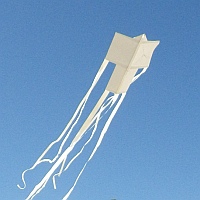 MBK Paper Sode
MBK Paper SodeConstruction time: about 5 hours.
This is the most complex kite so far in the series. However, if you have made the Paper Diamond, all the techniques and processes are very much the same. It's just a couple more spars and somewhat more cutting to make the tails.
This design hovers low in about 11 kph of breeze but floats up to a line angle of 50 degrees in ideal wind speeds close to 18 kph.
Up near 30 kph the kite starts to swish around from side to side. Much more than that and the thread will snap! So it's good through the entire gentle to moderate wind speed range.
Apart from the tails, the sode looks like a little model aircraft in flight. This kite climbs and descends smoothly in response to changes in breeze strength.
Here are free instructions for making the MBK Paper Sode.
Read about flying the sode in a very smooth sea breeze. On this day the breeze was as smooth as I have ever measured. There were just a few kph between the average speed and the maximum gust speed.
The MBK Paper Delta
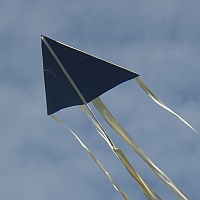 MBK Paper Delta
MBK Paper DeltaConstruction time: about 5 hours.
Despite a relatively simple overall appearance, this delta has more layering in the spars than the other kites. It took a lot of refinement to achieve an all-paper delta that ticked all the boxes: light enough, strong enough in all the right spots, and a just-right sail area that won't snap the thread below 30 kph of breeze strength!
This design hovers low in around 12 kph of breeze but floats up to a line angle of 45 degrees with wind low in the moderate range—about 20 kph or a bit above.
Over 25 kph the kite starts to swish around dramatically from side to side. Be careful flying inland where thermal gusts can put a lot of strain on the thread. Smooth onshore winds down at a beach are safer.
Depending on wind strength, this little kite might fly very steadily, or it might really zip around the sky. It looks good in a fast climb!
Here are free instructions for making the MBK Paper Delta.
Read about flying this delta in gusty inland air—as high as I dared! The field was huge, which was a good safety factor in case the thread broke. Of course, you could always choose to fly on polyester embroidery thread, which no Paper Series kite could ever snap.
Wind-Speed Handy Reference
Light Air
1-5 kph
1-3 mph
1-3 knts
Beaufort 1
Light breeze
6–11 kph
4–7 mph
4–6 knts
Beaufort 2
Gentle ...
12–19 kph
8–12 mph
7–10 knts
Beaufort 3
Moderate ...
20–28 kph
13–18 mph
11–16 knts
Beaufort 4
Fresh ...
29–38 kph
19–24 mph
17–21 knts
Beaufort 5
Strong ...
39–49 kph
25–31 mph
22–27 knts
Beaufort 6
High Wind
50-61 kph
32-38 mph
28-33 knts
Beaufort 7
Gale
62-74 kph
39-46 mph
34-40 knts
Beaufort 8
Sewing-Thread Lines
Regarding durability, it must be said that a sewing-thread flying line will often snap due to accidental snags—despite being "strong" polyester. Curious dogs, tree landings, and being caught on thistles and weeds and even on your own footwear are common causes for failure.
With experience, you do get better at minimizing breakages.
Line repair is quick and simple, using the Multi-Strand Double knot. While not the prettiest, it's simple to remember and retains a very good proportion of the thread's unbroken strength.
However, I have carefully designed and tested the kites to ensure that an in-flight breakage should be fairly rare. This is as long as you don't attempt to fly the kite in greater than moderate-strength wind! That is, winds above 28 kph or 18 mph.
The New York Times...
...were looking around for someone to do a "How to Make a Newspaper Kite" article. This was back in March 2021. Yours Truly got the gig :-) so I developed a rolled-paper-spar diamond for them. It has a span of about 48 centimeters (19 inches) and flies great on polyester sewing thread.
Check out the NYT Newspaper Diamond Kite here!
More about Paper Kites
Using my publications on how to make paper kites should be fun for just about any age group.
The designs are cheap enough to allow small kids to play with them after construction by an adult or teenager. After the inevitable happens, it's easy enough to make an identical kite on another occasion. Actually, it gets quicker and easier on the second or third time round!
But the kites fly so well that an adult can take their creation out and enjoy seeing it float around hundreds of feet up. With just a little care, the kites can remain airworthy for a long time—months or perhaps even years.
Artistic types could make an absolutely stunning piece of aerial art, since the material is paper! Admittedly, the piece would probably be described as a miniature. :-)




